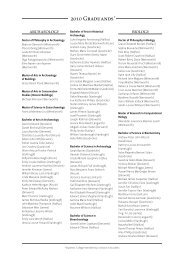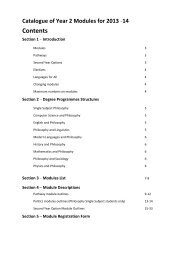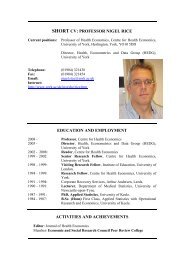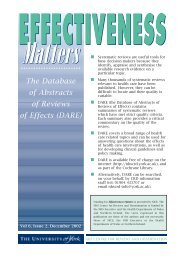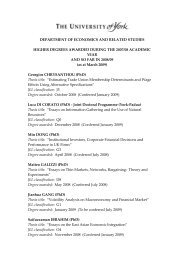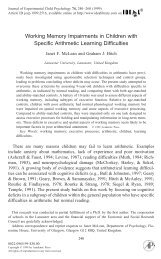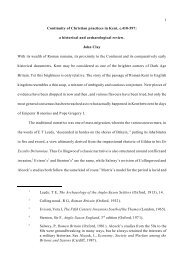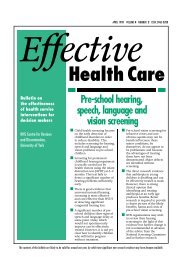Causal effects on employment after first birth - A ... - University of York
Causal effects on employment after first birth - A ... - University of York
Causal effects on employment after first birth - A ... - University of York
You also want an ePaper? Increase the reach of your titles
YUMPU automatically turns print PDFs into web optimized ePapers that Google loves.
3.2 Inverse Probability Weighting (IPW)To c<strong>on</strong>trol the selecti<strong>on</strong> <strong>of</strong> treated women, we estimate a sequence <strong>of</strong> quarterly propensityscores. 11 The probability <strong>of</strong> having the <strong>first</strong> child within the next year is modeled asa functi<strong>on</strong> <strong>of</strong> human capital and <strong>employment</strong> history, which is particularly important ifdecisi<strong>on</strong>s <strong>on</strong> having a child and decisi<strong>on</strong>s <strong>on</strong> the labor market career are taken jointly.As sequential labor market decisi<strong>on</strong>s are correlated (Troske and Voicu, 2010), c<strong>on</strong>trollingfor past labor market career is crucial for successful matching. Moreover, we c<strong>on</strong>trol forstatus <strong>of</strong> the relati<strong>on</strong>ship with the partner and for the self reported importance <strong>of</strong> havinga family. 12 We include covariates <strong>of</strong> the partner, such as income and educati<strong>on</strong>, tries toproxy the partner’s role in the joint decisi<strong>on</strong> process.Under the unc<strong>on</strong>foundedness <strong>of</strong> the treatment and perfect overlap in the propensityscore, Busso et al. (2009) c<strong>on</strong>clude that in small samples with unknown propensity score,a modified inverse probability weighting estimator (IPW) performs best in comparis<strong>on</strong> tovarious matching estimators. This result stands in c<strong>on</strong>trast to the c<strong>on</strong>clusi<strong>on</strong>s obtained bythe M<strong>on</strong>te Carlo study in Frölich (2004). The crucial modificati<strong>on</strong> <strong>of</strong> the IPW estimatorinvolves the normalizati<strong>on</strong> <strong>of</strong> weights for the n<strong>on</strong>treated women. According to the results<strong>of</strong> Busso et al. (2009), the poor performance <strong>of</strong> IPW reported by Frölich’s (2004) M<strong>on</strong>teCarlo study is due to the fact that Frölich does not normalize the IPW weights. Doing sostr<strong>on</strong>gly improves the performance <strong>of</strong> the estimator as found by Busso et al. (2009), whosuggest to estimate the ATT as follows (Busso et al., 2009, eq. (7)):(1)ˆθ BDM =∑ ni=1T i Y i∑ ni=1T i−∑ nj=1(1 − T j )ŴjY j∑ nj=1(1 − T j )Ŵjwith weights Ŵ j = ˆp(X j )/(1 − ˆp(X j )) .Furthermore, T i , T jdenote the treatment dummy variables for individuals i, j (treatedand n<strong>on</strong>-treated), respectively, and ˆp(X j ) denotes the estimated propensity score as afuncti<strong>on</strong> <strong>of</strong> covariates X j . The applicati<strong>on</strong> <strong>of</strong> the weights W j leads to a reweighting <strong>of</strong>the n<strong>on</strong>treated women according to the odds–ratio <strong>of</strong> having a child within the next year.Note that the denominator corresp<strong>on</strong>ds to the sum <strong>of</strong> the weights in the numerator.For our applicati<strong>on</strong>, we have to account for the fact that for the estimati<strong>on</strong> <strong>of</strong> treatmentversus waiting the group <strong>of</strong> eligible comparis<strong>on</strong> women changes by m<strong>on</strong>th <strong>of</strong> age.11 The size <strong>of</strong> the treatment sample is not sufficient to go down to a m<strong>on</strong>thly frequency when estimatingthe propensity scores. Furthermore, we think that the selecti<strong>on</strong> into child<strong>birth</strong> does not change str<strong>on</strong>glyfrom m<strong>on</strong>th to m<strong>on</strong>th.12 In fact, in c<strong>on</strong>trast to matching, the reweighting estimator we will use later requires the propensityscore to be a c<strong>on</strong>diti<strong>on</strong>al probability (Busso et al., 2009), which is evident in our applicati<strong>on</strong>. As there issufficient overlap, we do not require any trimming.11



